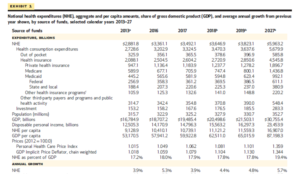The United States of Healthcare (SM) (Part 7)
A Post COVID-19 United States
We have all been consumed by the COVID-19 virus, and in a macabre way, maybe we’re looking at the county, state, national and international statistics too much. In a year or two from now, I am sure that sociologists will tell us how bad we all did and how it caused us more stress as a world, as a few billion people were under some form of shelter-in-place suggestion or mandate.
In our last blog, we took some time to discuss who are the likely winners and losers as businesses in the United States post COVID-19. The one undeniably safe prediction to make today is that healthcare cost and investments are going to increase materially from what the World Health Organization identifies as US $8 trillion, or just over 10% of Global GDP. Though we don’t know how much, it would not surprise me to see a 10% increase over pre-COVID-19 forecasts for the next few years in the United States alone.
A new report was issued by the U.S. Government Office of the Actuary, Centers for Medicare and Medicaid Services (CMS), in Baltimore, Maryland and published in March by Health Affairs. As we were securing our offices, so our staff could work from home, I grabbed my laptop and this report. I have it in a PDF because I still like to write notes on the research articles. I suspect this year’s report may be the least ever reported on with so much going on around us.
I typically write about these reports; not only to tell us what and where the nation spent in healthcare, but also their forecasts eight to nine years out. I discovered these reports decades ago and find them fascinating. Below is the actual abstract of this latest report.
ABSTRACT: National health expenditures are projected to grow at an average annual rate of 5.5 percent for 2018-27 and represent 19.4 percent of gross domestic product in 2027. Following a ten-year period largely influenced by the Great Recession and major health reform, national health spending growth during 2018-27 is expected to be driven primarily by long-observed demographic and economic factors fundamental to the health sector. Prices for health care goods and services are projected to grow 2.5 percent per year, on average, for 2018-27—faster than the average price growth experienced over the last decade—and to account for nearly half of projected personal health care spending growth. Among the major payers, average annual spending growth in Medicare (7.4 percent) is expected to exceed that in Medicaid (5.5 percent) and private health insurance (4.8 percent) over the projection period, mostly as a result of comparatively higher projected enrollment growth. The insured share of the population is expected to remain stable at around 90 percent throughout the period, as net gains in health coverage from all sources are projected to keep pace with population growth.
The abstract is scary, or it should be to policymakers, providers and consumers. The big picture is that healthcare will continue its 50 years plus growth. I don’t recall any year that healthcare costs have gone down, and with few exceptions, like strong economic expansions where healthcare as a percentage of GDP stalled, the trend has been even higher. Recently, the projections have been that healthcare in the United States will reach 19.4% of GDP by 2027. I personally believe that number is probably too low. This forecast was before COVID-19, and I believe that not only will it soon be proven wrong, I would expect a mid-year revision and most assuredly the GDP share of healthcare will be over 21%. I personally think it will reach 24% by 2030. Here is the graph, as it appeared in Health Affairs.

As we noted in our preceding blog, acute care facilities were not likely to fare well in this environment going forward. Many of my friends work in and for hospitals, and I had the honor to serve as Trustee of our local community hospital. Hospitals are a foundation of healthcare and account for about one-third of all healthcare expenditures in the United States, or about US $1.3 trillion annually. The COVID-19 crisis has deepened the financial impact on hospitals, and it is apparent these pressures will continue; and, as below, may even cause some hospital systems to file bankruptcy. The U.S. government has promised to cover the cost of uninsured care, but that may not be enough to make up for “elective procedures” canceled and the intensity of treating COVID-19 patients that has been estimated by some as upward of US $72,000 per patient.
Monday, (April 6, 2020) Bloomberg reported that Quorum Health Corp., a US $2 billion revenue hospital company based in the state of Tennessee and operating 24 hospitals across the United States, was preparing for potential Chapter 11 bankruptcy as COVID-19 has put extraordinary pressure on hospital operations.
We continue to believe that this will be a wake-up moment for healthcare world-wide, and in the United States in particular. We predict a transformation will soon emerge that will change the relationship of government, payors, employers, providers (at every level) and consumers. A change that will focus more on continuous monitoring, outpatient and in-home care, and a consumer more equipped with technology tools to better manage their own care. These changes in our healthcare system will, in turn, provide much needed scalability to our healthcare system and relieve hospitals of caring for patients that can recover or recuperate at home under continuous monitoring.
We believe this will be one of the more significant changes in the “healthcare system” in the United States to come out of this COVID-19 crisis.
Noel J. Guillama, President

